









‘We need every student in class, on time, every day ready to learn,’ said Dr. Saddler

By Ken Epstein
School reopens in Oakland this week, with tens of thousands of students and several thousand teachers returning to classrooms for their first time since May.
The district’s new superintendent, Dr. Denise Saddler, who assumed the position on July 1, visited nine schools Monday to observe classes on the first day and meet and welcome school families to the 2025-2026 school year.
Dr. Saddler, a veteran education professional with decades of

experience as a teacher, principal, and central office administrator in Oakland, visited United Nation Child Development Center, MetWest High School, La Escuelita Elementary, Martin Luther King Jr. Elementary, Peralta Elementary, Montera Middle School, Madison Park Academy Elementary, Frick United Academy of Language, and Fremont High School.
“There is nothing quite like the excitement and energy of a first day of school,” said Dr. Saddler in statement.
“Classrooms are decorated,
school floors are gleaming, playgrounds are bustling, students are reconnecting, and then the bell rings, and it’s ‘go’ time. Our educators (are welcoming) students into their classes to embark on a shared journey of teaching and learning for the next nine months,” she said.
Introducing herself to those who have not met her before, Dr. Saddler said, “I was born and raised in Oakland and have spent more than four decades working in OUSD. And no matter my role in the district, the first day of school is always exciting

By Magaly Muñoz
Oakland is in the next phase of updating its general plan for growth across the city. The new ideas will guide its development for the next 20 years.
The plan called “Oakland for All: Options for How We Stabilize and Grow” was released in late July with several options for priorities on where and what the city should implement by 2045.
The three options include Option A: A City of Neighborhoods; Option B: Connected Corridors and Gateways; and Option C: Midtown Waterfront District.

Option A would make Oakland neighborhoods more accessible by creating 18 walkable, mixed-use neighborhood centers that combine housing, transit, food and entertainment, and public use amenities, like parks and plazas.
Option B would significantly grow the city’s transit development by building residential and commercial use projects along the busiest streets and corridors. More frequent transit services and accessibility for pedestrians and bicyclists would be available under this option.
Option C would transform the
By Antoinette Porter
Greenlining Institute Hosts Leadership Academy 2025 Graduation
By Carla Thomas
The Greenlining Institute and the Greenlining Academy Alumni Association held their Leadership Academy 2025 Graduation on Friday, Aug. 8, at their headquarters in downtown Oakland. The sights and sounds of Mexico kicked off the celebration with a performance by Mariachi San Carlos.
Six students were recognized for completing the organization’s 11-month incubator session designed to provide trainees with the skills and knowledge to boldly fight for social and racial justice.
Advocacy and leadership graduates included Angel Lin, Dohee Kim, Eva Pitts, Gyaso Pigott, Swelihle “Sweswe” Tembe, and Sydney Guthrie.
Lin works with the Technology Equity team to develop a strategic understanding of existing and emerging regulations surrounding the algorithmic systems making key
‘His remarks (are) fearmongering and politically motivated — especially targeting predominantly Black-led cities,’ said Oakland Mayor Barbara Lee

By Ken Epstein
President Donald Trump, who himself has faced many accusations and charges of criminal behavior, fraud, and public corruption, has sent National Guard soldiers to the streets of Washington, D.C. allegedly to fight crime and warned the city’s homeless residents to get out of town immediately.
He said he might expand the crackdown to other major U.S. cities, including New York, Chicago, Baltimore, and Oakland,
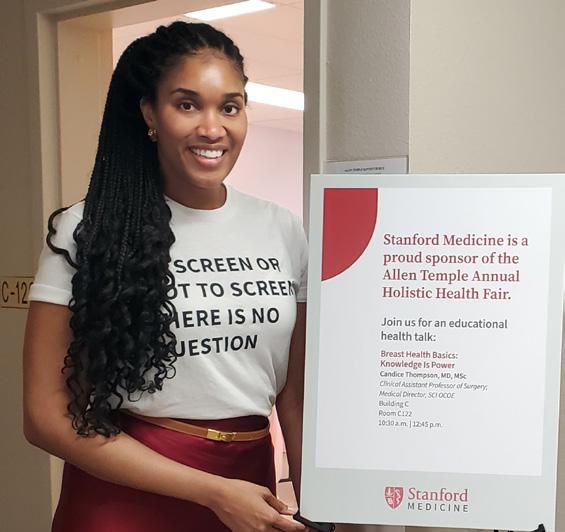
industrial area along the Central Estuary that connects to San Francisco by constructing new homes, businesses, parks, and other commercial businesses. New transit would connect the Fruitvale and San Antonio neighborhoods to this area, creating new job and housing opportunities.
While each option has its own set of priorities for development, all the options would include growth in Downtown Oakland, transportation corridors, existing neighborhoods, employment opportunities related to hospitals and
By Carla Thomas
On Aug. 9, breast surgical oncologist Dr. Candice Nicole Thompson delivered an insightful and informative presentation at the Allen Temple Baptist Church Annual Health Fair in Oakland. Her talk focused on disparities in breast cancer treatment, the urgency of early detection in Black communities, and the need for culturally competent care.
“Regular self-exams and recog-

all cities with Democratic leadership and African American mayors.
“We’re not going to lose our cities over this. This will go further. We’re starting very strongly with D.C., and we’re going to clean it up real quick,” Trump said, quoted in U.S. Today.
Already turning parts of Los Angeles into war zones at times, the President has troops and federal immigration agents roaming communities in Southern Cali-
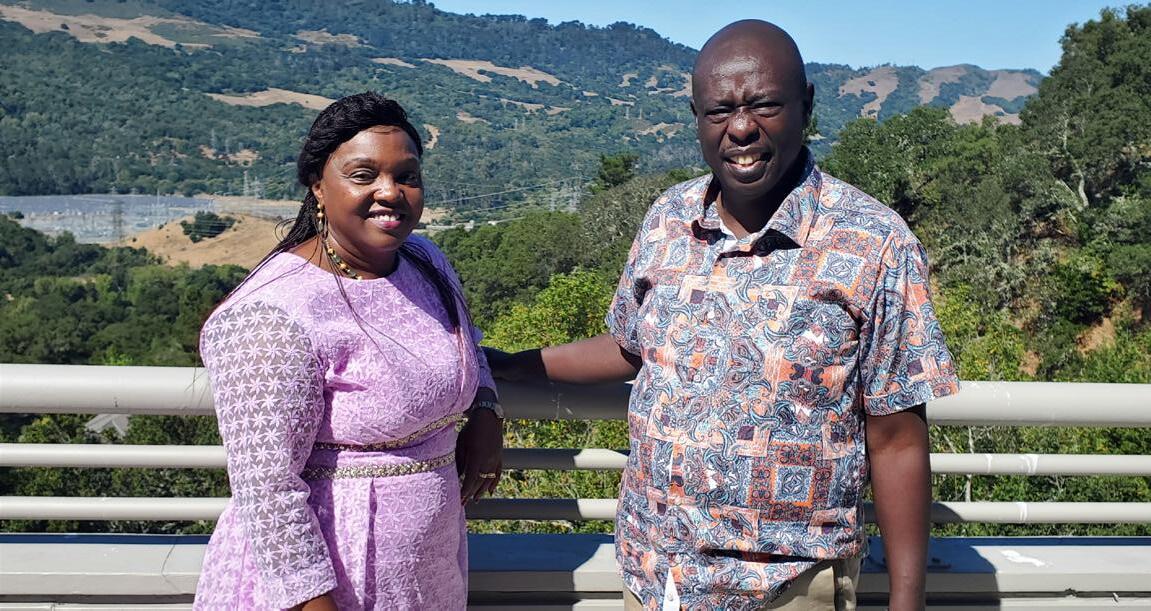
By Carla Thomas
The Kenyan community of the Bay Area welcomed His Excellency Rigathi Gachagua, former deputy president of the Republic of Kenya to a town hall at Holy Names University in Oakland on Aug. 8
The historic visit marked a moment of pride and recognition for the African immigrant community in the Bay Area, which has long contributed to the region's cultural and economic fabric but has often been underrepresented in
civic events.
The former deputy president's presence in the Bay Area is a significant gesture of connection between the African diaspora and global leadership.
During the town hall, Gachagua discussed the state of Kenya, and a call to action to liberate the nation from dictatorship, economic mismanagement, and abuses of the law.
"We must put an end to corruption, extrajudicial killings,
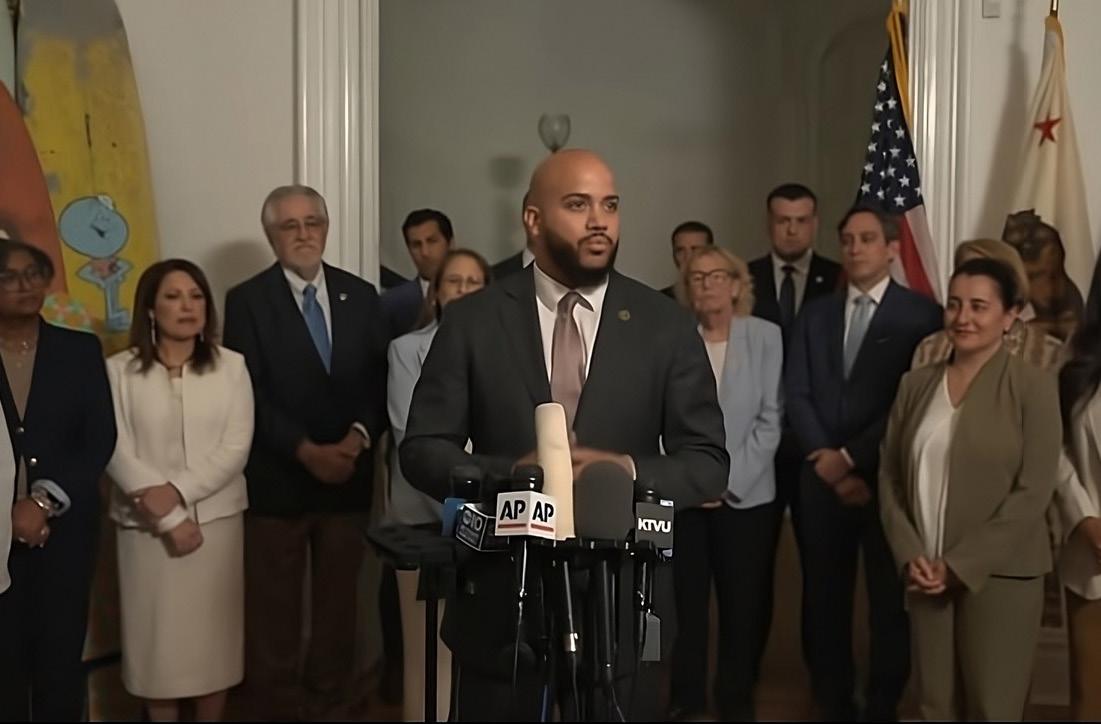
By Antonio Ray Harvey California Black Media
“California cannot sit back and let that happen. We have a responsibility to step up.
We are going to step up,” said Assemblymember Isaac Bryan (D-Ladera Heights).
Bryan was speaking at a news conference where Gov. Gavin Newsom, Senate President pro tem Mike McGuire (D-Healdsburg), Assembly Speaker Robert Rivas (D-Salinas), U.S. House of Representatives Speaker Emerita Nancy Pelosi, and other state lawmakers welcomed Texas Democrats to Sacramento to back plans for redrawing California’s congressional maps ahead of the midterm elections.
Bryan said where he’s from in Los Angeles, “when they go low, we squabble up.”
“That doesn’t mean we are
abandoning our values, continued Bryan. “We are not doing away with the independent commission that we establish every single decade, but we are meeting this moment because this is not a turnthe-other-cheek moment while they continue to send blow after blow to the foundations of our democracy.
The move to redraw California’s electoral maps comes in response to efforts by Texas Republicans to redraw their maps, potentially gaining five seats in the U.S. House of Representatives — a reported request from President Donald Trump to Texas Gov. Greg Abbott.
“They will lose in the midterms and (Trump) knows it. Why else would he make that phone call,” Newsom said. “His agenda is failing. His presidency is failing. He’s dialing for seats.”
Texas State Representatives Rhetta Bowers, Gina Hinojosa,
Ann Johnson, Ray Lopez, Mary
Ann Perez, and Vince Perez were in attendance, along with U.S. Rep Zoe Lofgren (D-CA-18) and several California state legislators.
The news conference took place at the California Governor’s Mansion Historic Park, a site that served as the official residence for California governors for over 60 years, located a short drive from the State Capitol.
Newsom is looking ahead to a special election on Nov. 4, 2025, where voters will consider the redistricting measure. The proposal could add five congressional districts favorable to Democrats, potentially reducing Republican seats from nine to four out of 52.
In California, the redrawing of Congressional, State Senate, and State Assembly district lines is managed by the California
Continued

By Bo Tefu California Black Media
California lawmakers are advancing two bills that would use $15 billion in state bond financing to pay for major utility grid upgrades, aiming to ease the state’s soaring electricity rates.
The measures, Senate Bill 254 by Sen. Josh Becker (D-Menlo Park) and Assembly Bill 825 by Assemblymember Cottie Petrie-Norris (D-Irvine), would shift a portion of planned utility infrastructure spending from ratepayer-funded capital projects to lower-cost public financing.
Supporters say the move could save Californians billions over the next decade by replacing profitdriven utility investments with state-backed bonds.
Utility customers in California now pay nearly twice the national average for electricity, and almost one in five are behind on their
bills, according to state regulators.
The state’s three largest utilities, Pacific Gas & Electric, Southern California Edison, and San Diego Gas & Electric, have faced mounting criticism as wildfireprevention projects and grid expansions increase costs.
“This is different from what we’ve seen in the past — and the solutions being sought by the legislature are more ambitious than what we’ve seen in recent years,” said Matthew Freedman, senior attorney at The Utility Reform Network (TURN), which supports SB 254.
TURN estimates the proposals could save about $8 billion over 30 years, with $7.5 billion of those savings coming in the first decade, which amounts to roughly $4 to $5 a month for the average residential customer.
Both bills have cleared their respective chambers despite opposition from investor-owned
By Edward Henderson, California Black Media
The California Governor’s Office is pushing back on the findings of a July 2025 study published by the National Bureau of Economic Research (NBER).
The study reports that California’s 2024 minimum wage increase to $20 for fast food workers cost the state 18,000 jobs.
Gov. Newsom's deputy director of communications Tara Gallegos disputed the findings of the piece, adding that the research paper was linked to the Hoover Institution, a public policy think tank she claimed has published “false or misleading information” about California's minimum wage hike “that later had to be completely retracted.”
The California Assembly passed Assembly Bill (AB) 1228 in September 2023, which raised the minimum wage and formally established the “Fast Food Council” and its ability to set and adjust the industry’s minimum wage which was $16 at the time.
The bill, authored by former Assemblymember Chris Holden (D- Pasadena), a member of the California Legislative Black Caucus, was signed into law by Gov. Gavin Newsom and went into effect on April 1, 2024.
Jonathan Meer, a researcher at the NBER, spoke with California Black Media about the organization’s motivations for publishing the report and defended the study’s methodology and transparency.
“We worked on minimum wage issues for some time, and we have concluded that relatively small

increases are unlikely to have major impacts on employment levels in the short run,” said Meer. “But the California fast food increase was quite large – well outside the bounds of anything we’ve seen previously – and it made for an interesting case study.”
Meer acknowledges the governor’s office criticism of the study but insists NBER took the right approach. He even hinted that jobs lost due to the increases could be higher.
“That’s why our figures start with the raw data plots and show each adjustment we made, explaining clearly how and why it was done. Most of those adjustments are ones that minimum wage proponents in the academic literature have argued are crucial to ensuring that the right comparisons are being made. We produced an array of estimates based on those adjustments, and our “headline” number [18,000 jobs lost] is the median estimate,” said Meer.
Another study, conducted by the Institute for Research on Labor and Employment at UC Berkley, found “estimated wage increases of 8% to 9% for workers covered
by the policy; no spillovers to non-covered workers; no negative effects on fast-food employment; and price increases of about 1.5% — or about 6 cents on a four-dollar hamburger.’ Additionally, the number of fast-food establishments grew faster in California than in the rest of the U.S.
Michael Reich, the author of the study, said he observed “questionable methods” in a recent study on the same subject claiming the pay raise led to substantial negative employment effects and large price increases.
“That report cherry picks its numbers and does not use modern causal identification methods,” Reich noted in the abstract.
Across California, nearly 80% of fast-food workers are people of color and about two-thirds of them are women, according to the California Fast Food Workers Union. And the nonpartisan Legislative Analyst’s Office (LAO) reports that fast food workers – cooks, cashiers and counter workers — make up the second largest group of low wage earners in California, behind home care aides.

utilities, which argue public financing would cut into profits they earn on infrastructure spending.
SB 254 takes a broader approach, covering wildfire mitigation and grid expansion for growing electricity demand, while AB 825 focuses on undergrounding power lines to reduce wildfire risk. Lawmakers also included provisions to explore long-term public financing for large-scale transmission projects, modeled after similar efforts in New York and other states.
Supporters say public financing would not solve California’s affordability crisis but could deliver quick relief and position the state to control costs on future clean-energy investments.
“There’s no silver bullet,” Freedman said. “But we’re trying to get some near-term benefits here.”
By Bo Tefu California Black Media
Community leaders across California are invited to attend the 2025 Listos California Regional Disaster Ready Summits, a statewide series of emergency preparedness workshops designed to strengthen local resilience before the next crisis hits.
The free events will take place in 10 cities from August through September, helping attendees become trusted messengers in their regions. Each summit offers hands-on tools, planning resources, and peer-to-peer connections to support disaster readiness in California’s most vulnerable communities.
Listos California launched the summit series in 2023 to bring emergency preparedness directly to community leaders. Unlike traditional disaster trainings, these summits emphasize trust-building, collaboration, and culturally
responsive solutions.
“This work is about more than checklists,” said a spokesperson for Listos California. “It’s about people, relationships, and the kind of local knowledge that saves lives in emergencies.”
This year’s sessions will include plenary discussions and interactive breakout activities that help attendees assess regional needs, share strategies, and apply human-centered problem-solving approaches. Participants will leave with resources to support preparedness in their communities before, during, and after disasters.
Recommended attendees include emergency managers, local government communicators, CERT leaders, faith leaders, and representatives from communitybased organizations and private companies involved in preparedness.
2025 Regional Disaster Ready
Summit Dates:
28 – San Jose
2 – Tulare (Spanish-language session with English translation) ● Sept. 9 – San Luis Obispo ● Sept. 12 – Los Angeles
● Sept. 16 – Rancho Mirage ● Sept. 18 – Chula Vista Organizers suggest attending the summit closest to your service area for region-specific learning and networking. Space may be limited, so early registration is encouraged.
Listos California’s mission is to ensure all Californians, regardless of language, income, or access, are prepared when disaster strikes. These summits are part of a broader push to promote equity, coordination, and trust in emergency response efforts statewide.



Everlaw, Inc. is hiring in Oakland, CA: Software Engineers: Dsgn & implmnt features such as doc upload, search, grouping, review, asgmt, coding, redactions, clustering & other features of the Everlaw Pltfrm. Expctd salary range for role is b/w $155,605 & $190,000. Software Engineers (Midlevel): Wrk w/Prdct & Dsgn teams by applying prfssnl exp to implmnt & release new features to the Everlaw e-discovery Pltfrm. Expctd salary range for role is b/w $130,250 & $181,000. Both positions may wrk remotely w/in commuting distance of Oakland, CA ofc. Final offered salary for all roles is depndnt upon candidate’s exp & skills. Base pay range is subj to change in the future. Send resume ref. position to everlawapplication@everlaw.com.
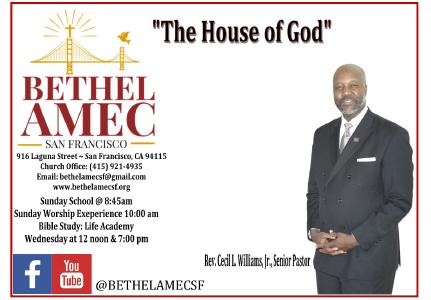
erts is excerpted from the MacArthur Fellows web site.
A graduate of Yale University with a law degree from Harvard, Dorothy Roberts is a legal scholar and public policy researcher exposing racial inequities embedded within health and social service systems.
She endured their hazing and sexual harassment. She endured their racism and juvenile jokes. She endured a noose left laying on her study manuals.
Sine 2012, she has been a professor of Law and Sociology, and on the faculty in the department of Africana Studies at the University of Pennsylvania.
Less than six months aboard, she says, “my anger had become a living thing, and even though I didn’t want it, I kept that anger close. It leapt ahead of me when it had to.”
Tony Cokes,
olds, and Dorothy Roberts. This is the eighth and last in the series highlighting the Black awardees. The report below on Dorothy Rob
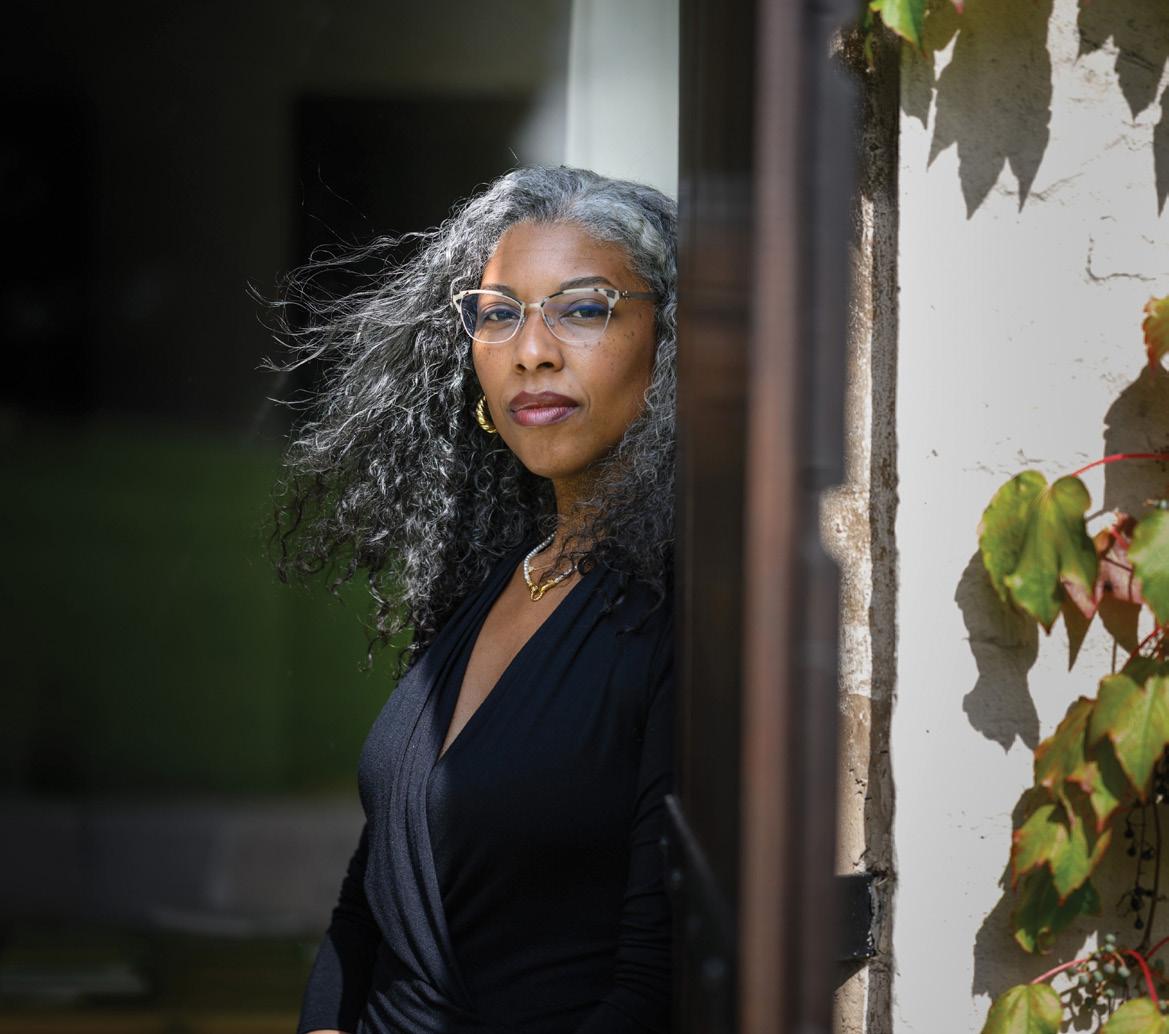
By Terri Schlichenmeyer
The Bookworm Sez
Author: Khadijah
Queen, Copyright, c.2025, Publisher: Legacy Lit, Price: $30.00, Page Count: 348 pages
Keep your head down.
Stay steady, mind your business, and don’t compare yourself to others. You are where you are for a reason, don’t lose sight of it.
There’s a prize at the end, and endurance is the only way to get it.
You have a job to do and, as in the new memoir “Between the Devil and the Deep Blue Sea” by Khadijah Queen, you’ll do it until you can’t.
Khadijah Queen hated Inkster, Michigan.
She had begged to stay in L.A., but her mother ignored her pleas and moved the family to Inkster to take care of the at-risk children of Queen’s addicted eldest sister. Not old enough to stay in “Cali” by herself, but old enough to work
and contribute to the household, Queen rushed to sign up for classes at a local Michigan college because she knew education was the only way to escape the situations that had her family in a stranglehold.
Alcoholism, drug abuse, no money — problems came like storms and when those problems forced her to drop her classes, she decided to join the Navy. After a few years of service, she knew her college education would be free. Happily, Boot Camp wasn’t so bad.
There were a handful of Black recruits and personnel who held Queen up when she felt sad and they gave her hope. She learned in Navy Boot Camp that she was a leader, but she wasn’t fully ready for it. She wanted to serve on a submarine and once there, she tried to just do her job but her White male shipmates made it difficult.
Roberts’s work encompasses reproductive health, bioethics, and child welfare. She sheds light on systemic inequities, amplifies the voices of those directly affected, and boldly calls for wholesale transformation of existing systems.
Prepared to be stunned.
Roberts’s early work focused on Black women’s reproductive rights and their fight for reproductive justice. In “Killing the Black
From the first few pages to this books’ roaring end, “Between the Devil and the Deep Blue Sea” grabs readers by the throat and doesn’t let go. You plainly see author Khadijah Queen’s need to get away from near-poverty; it paces like a lion in a small cage. You’ll cringe at her maturity that doesn’t quite go far enough because you’ve probably been there, too. When she’s about to get in trouble for speaking her mind or because she’s impatient, you’ll squirm, knowing what’s coming.
Authentic language puts you in uniform. Tragedy will hurt your heart. So will some of the people in this book when you learn what happens to them, but the story would be lesser without the rich presence of each of them and without Queen’s no-nonsenseness, her boiling impatience, and her profanity-laced honesty.
Veterans may have some things to say about this one-of-akind book, as will feminists, and neither of them, nor you, should miss it. Start “Between the Devil and the Deep Blue Sea” and it’ll keep your head down good.
This work prompted Roberts to examine the treatment of children of color in the U.S. child welfare system.
state intervention and the results of-
ed with Child Protective Servicestions regularly punish the effects

ilies, especially if they are lowincome, and children from these families are much more likely than white children to be removed from their families after CPS referral.
By Tamara Shiloh
The First African Baptist Church, located in Savannah, Georgia, is one of the oldest continuously operating African American churches in the United States. Established officially in
After nearly two decades of research and advocacy work alongside parents, social workers, family defense lawyers, and organizations, Roberts has concluded that the current child welfare system is in fact a system of family policing with alarmingly unequal practices and outcomes. Her 2001 book, “Shattered Bonds: The Color of Child Welfare,” details the outsized role that race and class play in determining who is subject to
In “Torn Apart: How the Child Welfare System Destroys Black Families—and How Abolition Can Build a Safer World (2022),”
Roberts traces the historical, cultural, and political forces driving the racial and class imbalance in child welfare interventions.
1788, the church’s history is deeply tangled with the struggles and triumphs of African Americans from the era of slavery to the present day. It stands today not only as a house of worship but also as a living monument to community
These include stereotypes about Black parents as negligent, devaluation of Black family bonds, and stigmatization of parenting practices that fall outside a narrow set of norms.
She also shows that blaming marginalized individuals for structural problems, while ignoring the historical roots of economic and social inequality, fails families and communities.
Roberts argues that the engrained oppressive features of the current system render it beyond repair. She calls for creating an entirely new approach focused on supporting families rather than punishing them.
Her support for dismantling the current system of child welfare is unsettling to some, but her provocation inspires many to think more critically about its poor track record and harmful design.
and cultural heritage. The church traces its origins back to 1773, when a group of enslaved and free African Americans began gathering to worship under the leadership of George Liele (laylee), who became the first African American ordained as a Baptist minister. When Liele left for Jamaica, leadership passed to Andrew Bryan, a formerly enslaved man whose unshakable faith helped formalize the congregation. Andrew endured persecution and even physical beatings for preaching to African Americans, yet his congregation continued to grow. Under his leadership, the First African Baptist Church was officially organized in 1788, making it a foundation of African American religious life in the early United States. In the 19th century, the church played a critical role in the fight against slavery. It became an important stop on the Underground Railroad, providing shelter to enslaved individuals escaping to freedom. Beneath the church’s sanctuary, visitors can still see holes carved in the shape of an
By uncovering the complex forces underlying social systems and institutions, and uplifting the experiences of people caught up in them, Roberts creates opportunities to imagine and build more equitable and responsive ways to ensure child and family safety.
Continued on page 6




Continued from page 4
African prayer symbol, which were used to provide ventilation for those hiding below. These architectural details serve as powerful reminders of the church’s active participation in the struggle for liberation.
The church building, completed in 1859, was constructed largely by enslaved members of the congregation. Its architecture tells a story of cultural blending and survival. The ceiling resembles an inverted ship’s hull, a haunting yet beautiful reminder of the transatlantic slave trade. The hand-carved wooden pews, still in use today, bear African tribal markings and other symbolic designs that preserve the cultural identity of the church’s builders.
Beyond its historical significance during slavery, the First African Baptist Church remained a hub for the African American community through the 20th
Continued from page 2
Citizens Redistricting Commission (CCRC), an independent 14-member body, according to the California Secretary of State. The commission uses U.S. Census data to redraw the lines.
Newsom and the Democrats’ plan would override California's independent redistricting commission maps.
The California legislature is currently in recess until Aug. 18. Lawmakers have five days upon return to officially initiate a special election. At the news conference, Rivas said redistricting maps would be released the week of Aug. 11, 2025.
Afterward, the public will have ample time to review the maps in
century. During the Civil Rights Movement, the church hosted meetings and inspired leaders who were working to dismantle segregation and secure equal rights. It continues to serve as both a spiritual and cultural center for its congregation and the broader community.
Today, the First African Baptist Church functions as both an active place of worship and a historical landmark. Visitors from around the world come to walk its sacred halls, explore its museum, and reflect on its legacy. Its continued existence reminds us of the endurance of faith and the unyielding quest for freedom.
The First African Baptist Church is more than a historic building; it is a testament to the strength and perseverance of generations who faced oppression but never lost hope. As a spiritual home and a historical treasure, it stands as a beacon, illuminating the path of faith and freedom for all who enter its doors.
the lead-up to the special election.
“We are going above and beyond to ensure we are protecting the Voters' Rights Act and sending the voices of our most vulnerable to Washington, D.C.,” Rivas said.
Before the 2026 midterms, at least 13 states may consider redistricting, with Texas, California, Florida, and Ohio leading the changes in Congressional representation.
Pelosi voiced her support for the Texas Democrats who left the state to block the vote, saying Republicans are not committed to the electoral process.
“The Republicans are acting because they have a bankruptcy of ideas,” Pelosi said. “They have no winning ideas to present to the American people, and they cannot defend their actions legitimately.”
By Post Staff
Come and eat black-eyed peas, the iconic legume that originated in West Africa that is one of the stars of any soul food menu, at the 10th Annual Oakland Black-Eyed Pea Festival (BEPF).
Held on Sept. 13 at Marston Campbell Park at 17th and West streets in West Oakland, the festival is a celebration of traditional African American music, food, and art.
Grammy-nominated Andre Thierry of Accordion Soul Music, second-line band MJ’s Brass Boppers, the Oakland School for the Arts jazz band, and vocalist Piwai’s genre-bending send up of jazz and reggae influenced by her Zimbabwean traditions will grace the stage MC’d by Dance-A-Vision’s Carla Service, who will help keep you moving.
To satisfy your appetite, the festival will feature several caterers and chefs whose menus offer black-eyed peas prepared in different ways and styles as well as festival fare for those who (how is it possible?) don’t like them.
Growing up in Cameroon in West African, Marie Schreiner learned to cook from her mother who was a healer. Sent to the woods to get the roots and herbs used in meals, Schreiner applies the same healing principles now as she cooks for the public through Kilama Balondo Passion Foods.
Once a staple at the Berkeley Flea Market and a former vendor for the San Francisco Giants, Schreiner will bring standard Cameroonian fare: plantains, coco yams, sweet yams, black beans and fried fish and chicken cooked Camer-
The Peralta Community College District (PCCD) is seeking proposals from qualified firms, partnerships, corporations, associations or professional organizations to provide Management of Bookstore Operations Services, District Wide (RFP No. 25-26/02). Proposals are to be delivered electronically (via Planet Bids), until 3:00 P.M. on September 11, 2025
The District is seeking a partnership for managing all aspects of the District’s bookstore services, including, but not limited to, the sale of textbooks (both new and used), course materials, digital content, school supplies, spirit apparel, technology products, and other related merchandise. The District is committed to ensuring that bookstore operations support student success by offering affordable, accessible, and innovative solutions.
There will be a Mandatory pre-proposal Zoom meeting on August 21, 2025 at 10:00 a.m.
Zoom Meeting Link: https://peralta-edu.zoom.us/j/88093646058
Copies of the proposal documents may be obtained at PlanetBids via: https://vendors.planetbids.com/portal/71895/portal-home
Advertisement Dates: 8/8/25 and 8/15/25
Governing Codes: GC 53068
EC 81641

oonian style as well as a blackeyed pea croquette.
Chef Sharon Lee’s menu is all black-eyed peas: a savory BlackPea Soup made with fresh herbs and handcrafted special seasoning, pork sausage, shrimp, and thigh meat. The vegetarian black-eye pea salad features fresh chopped herbs, sliced cherry-heirloom tomatoes, roasted white/yellow corn, and olive oil mustard vinaigrette. “I have waited for the time and opportunity to join this festival,” said Lee, owner of The Spot for Fine Catering, in an email. “It is a dream come true, so magical. I am so glad to bring healthy, sustainable food for the soul and mind. The Pea Festival

is the Best in the West, and I am a part of it.”
Chef Kathy Van Ness, of Ate o’ Clock, can be found many weekends at events or on the Grand Avenue side of Lake Merritt. Besides the peas, her typical pop-up soul food plate includes oxtails, greens (collard and/or cabbage), rice, mac ‘n’ cheese, fried catfish and more.
Her uncle, Hal Stevens, says the BEPF will have hot links, turkey, tofu hot dogs and bratwurst on the grill and a new specialty: a portobello mushroom slider with black-eyed peas. Then there’s the sauerkraut condiment that, as he says, “give those hot dogs that real New York style and taste.”

Annabelle Goodridge, owner of Cocobreeze Caribbean Restaurant and Bakery brings Trinidadian fare to the festival with a curried goat, fried catfish, vegan ‘jerk chicken,’ plantain, coco rice and fresh juices.
Other offerings shifting away from the black-eyed pea menu theme include caterer Alicia Waters, of This Is Maldoni’s, who will bring, as she says, “lipsmacking stuffed potatoes.”
Not eating? It might get warm out there and that’s where Rainbow Italian Ice by Michael Dabney will help keep you cool. A veteran of the festival, he brings “the flavor but not the fat to all those happy faces. See you there!”
The 10th Annual Black-Eyed Pea Festival, a celebration of traditional African American music, food, and art, on Sat. Sept. 13, from 11 a.m. to 6 p.m. at Marston Campbell Park, 17th and West streets in West Oakland. For more info, go to Oakbepf.com or call 510-332-5851. Bring a chair or blanket for the lawn or reserve a table for six for $150 at https:// www.tickettailor.com/events/omnirainstitute/1799229

1111 Broadway, Suite 800, Oakland, CA 94607 (510) 208-7400 • www.alamedactc.org
Request for Qualifications (RFQ) for Express Lanes Infrastructure Maintenance Services (RFQ No. R26-0001)
The Alameda County Transportation Commission (Alameda CTC) is seeking Statements of Qualifications (SOQ) for a contract to commence services in January 30, 2026, or as indicated in the RFQ and/or appropriate addenda.
Key Dates:
- Pre-submittal conference will be held online: August 15, 2025, at 1:00 p.m. Pacific Time (PT)
- SOQ due date: September 9, 2025, at 3:00 p.m. PT
This contract will be funded entirely by express lanes toll revenues and as such, will not be subject to any Disadvantaged Business Enterprise (DBE) goals or the Alameda CTC Local Business Contract Equity Program. However, Alameda CTC strongly encourages each proposer to consider the use of disadvantaged, local and/or small business enterprises in its SOQ. Any contract resulting from this RFQ will be awarded without discrimination based on race, color, religion, sex, sexual orientation or national origin. All RFQ documents are available on the Procurement Portal at https://alamedactc. bonfirehub.com. All questions regarding this RFQ must be submitted via the Procurement Portal, no later than 3:00 p.m. PT on August 21, 2025. Submittals must be made in accordance with the instructions in the RFQ.
By Emil Guillermo
I’m heading back to Canada to be among the sane at the Edmonton Fringe Festival.
That’s not Edinburgh in Scotland, the mecca of Fringe theater. But Edmonton in Alberta, the largest fringe festival in North America.
I’m telling my story, “Emil Amok: 69.” Come see it if you’re close by. It’s my one-man show of how I prescribe dealing with the major story of our lives — the dramatic slide of our democracy to autocracy.
I surely won’t annoy Canada with Trump’s 51st state nonsense.
After this week, it’s clear the District of Columbia, not Canada, should be the 51st state.

But do we have an emergency?
Of course, not.
That’s a hurdle Trump ignores as the occupation of D.C. begins with National Guard and FBI agents who aren’t even trained in “walking the beat” kind of policing.
Those agencies are all about intimidation and fear, and that’s the point.
that coincidentally are blue cities, like Chicago and Los Angeles.
“Of course, Baltimore and Oakland, we don’t even mention that anymore,” added Trump. “They’re so far gone.” Only when it comes to supporting Trump.
This week, Trump establishes the narrative that urban cities with big populations of minorities are bad. It enables him to use D.C. as the model for an unprecedented display of force to come.
It’s Trump’s emerging police state, the gestation period for U.S. martial law?
And if you saw the power grab Monday, then you saw the naked intentions of an autocrat in waiting. Trump jumped over the sovereign government of DC to send in the national guard and FBI to terrorize the city. Practice for martial law next?
No emergency exists.
On the same week he meets with the Russian dictator. Trump is acting very Putin-y.
By invoking the “Home Rule Act of 1973,” from the Nixon years, Trump takes control of the D.C. police for 48 hours — if he “determines” an emergency exists.
tification. Not when D.C. officials cite legit crime stats that show that crime is the lowest in D.C. in years.
That didn’t stop Trump from comparing the D.C. crime rate to Mexico City, Bogota, Columbia and Lima, Peru, which he implied where drug and crime infested cities. But totally irrelevant as a jus-
Trump did mention some isolated incidents of supporters as crime victims, including the recent beating of a former Department of Government Efficiency (DOGE) person in D.C.
But savor the irony. Trump didn’t invoke any such power on Jan. 6, 2021, when the biggest threat to D.C. were Trump/MAGA insurrectionists who ransacked the Capital as they tried to steal the election. Jan. 6 resulted in the deaths of five police officers.
Trump pardoned all those convicted and involved in the insurrection.
But now he invokes this?
Is he just testing, and is Oakland next?
At the news conference, Trump talked about other “bad” cities,
About the Author Emil Guillermo is an awardwinning journalist, news analyst and comic stage performer. He has written a weekly “Amok” column for more than 30 years. Find him on YouTube, patreon and substack. See him live at the Edmonton Fringe starting Aug. 15.


Omega Psi Phi Fraternity Members Welcome Students on Opening Day at East Oakland Pride Elementary School

By Brother Tony Anderson, Ph.D
One of the most exciting days of the school year is the opening day. Summer is over and it is time to go back to school. The brothers of Omega Psi Phi Fraternity, Inc. Sigma Iota Chapter, in partnership with the East Oakland Pride Elementary School, provided an enthusiastic welcome line as the happy students came into the building on Monday, Aug. 11, 2025, for their opening day.
The school’s principal, Michelle Grant, gave hugs to many students and called them by name as she warmly met them and their parents at the front door of the school building entrance where the brothers of Omega lined up in their purple shirts.
There were plenty of smiles on
the faces of the students and parents as the brothers applauded and cheered, “Welcome Back to School … Have a Great Day!”
The brothers of Omega had the opportunity to visit the classroom of fraternity member Ken Bazile, who is a fourth-grade teacher at the school. They were able to meet and greet the excited students in his classroom and they expressed a desire to see them over the course of the school year.
Another fraternity member, Godfrey White, President of the Bayou Meets the Bay Classic Foundation, that supports PreK educational programming in the community, had a productive talk with the principal about the potential of his program being implemented at her school.
It was a good

California Lawmakers Consider Bill to Ease ShortTerm Guardianships Amid Immigration Concerns
By Bo Tefu
California Black Media
California lawmakers are weighing a proposal aimed at helping families maintain stability when parents face sudden separation — particularly due to immigration enforcement.
Assembly Bill 495, authored by Assemblymember Celeste Rodriguez (D-San Fernando) and dubbed the Family Preparedness Act of 2025, would create a streamlined process in probate court for short-term guardianships. The measure allows parents to temporarily place their children in the care of a trusted adult without giving up parental rights.
“The cruel and unlawful federal immigration enforcement actions are spreading fear through many communities like mine,” said Rodriguez in a statement.
“Californians are scared to go to work, send their kids to school or make their medical appointments,” Rodriguez continued. “I am working on AB 495 with trusted legal attorneys and children’s advocates to help families facing family separation make caregiving arrangements
The bill expands the definition of “non-relative extended family member” eligible to receive a caregiver’s authorization affidavit, which grants legal authority to make decisions about a child’s education and health care. It also restricts how much schools and child care providers can cooperate with immigration authorities, a safeguard proponents say is key to keeping children in familiar environments.
Supporters argue the legislation would prevent service disruptions for children and give temporary caregivers legal recognition, ensuring they can enroll minors in school, take them to the doctor and meet other daily needs.
Critics, however, worry the bill could inadvertently weaken pa-
rental rights or open loopholes for custody disputes.
“Presto, someone walks away with your child.” This frightening possibility is compounded by the language of the bill, which does not limit its application to immigration-related scenarios but instead extends to any child for any reason,” says Erin Friday, a lead advocate against the bill. The legal implications are staggering: medical decisions, educational enrollments, and treatments of any nature could be made by strangers, removing parents from the equation entirely.
AB 495 cleared the Assembly earlier this year and now heads to the Senate Appropriations Committee for review later this month. If passed, it would mark one of the most significant changes in California’s guardianship laws in years.
“As California embarks upon this concerning legislative path, it’s essential for lawmakers and citizens alike to recognize the potential ramifications of AB 495,” said Craig DeLuz, director of communications for the California Republican Assembly.
“No one disputes the need for compassion in times of crisis; however, it must be balanced with adequate protections to ensure that children, the most vulnerable among us, are not left at the mercy of unwarranted and unmonitored authority. Compassion without guardrails is not an act of mercy— it is a recipe for chaos, endangerment, and potential tragedy,” said DeLuz.
“Let me be clear, a caregiver’s authorization affidavit does not grant any level of legal custody, does not bypass child welfare protections, does not prevent authorities from investigating abuse or trafficking concerns, and does not supersede any parents’ rights,” said Rodriguez.

By Joe W. Bowers Jr. California Black Media
President Donald Trump’s latest executive order requires colleges receiving federal aid to submit detailed admissions data — including race, GPA, test scores, and acceptance rates — to prove they aren’t using race, directly or indirectly, in admissions decisions. Noncompliance may trigger federal enforcement actions, including corrective plans, loss of federal student aid eligibility, and possible referral to the Department of Justice.
The White House claims that this order supports fairness and transparency, but critics warn it’s a veiled attack on racial diversity in higher education. Yale Law professor Justin Driver called the new approach “catastrophic” and said it would likely be used to intimidate universities into lowering Black and Latino enrollment.
Trump’s order follows the 2023 U.S. Supreme Court decision ending race-conscious admissions but allowing students to write about how race affected their lives. The administration is now targeting perceived “racial proxies,” including personal essays, diversity statements, and ZIP-code or firstgen indicators, tools that many colleges legally use in building a diverse student body and ensuring that underrepresented voices are part of campus life.
What This Means for Black Students in California In 1996, California banned affirmative action with Proposition 209. The result was immediate. In the first year at UCLA, Black student admissions fell by 36%, and Latino admissions by 21%, despite no significant drop in applicants.
Today, the long-term effects remain visible. According to UC system data, Black undergraduates made up just 4.7% of all students in fall 2024 — well below California’s Black population share of 5.6%. Despite these constraints, UC
enrolled its most diverse freshman class ever for fall 2024: African American enrollment increased 4.6% systemwide, Latino enrollment rose 3.1%, and American Indian enrollment was up about 12.9%.
After the Supreme Court ruling, UC President Michael V. Drake reaffirmed UC’s commitment to diversity: “Student diversity remains a top priority for the University of California — one that we will continue to pursue with every tool available to us.”
Merit — or Misdirection? Trump officials say the order defends “merit-based” admissions. Secretary of Education Linda McMahon said students should be chosen based on “achievement and ability — not race or ideology.”
The facts show the policy defines merit in a narrow, one-dimensional way - focusing on test scores and grades - while ignoring other admissions factors like legacy status and donor preferences that disproportionately benefit wealthy White students.
Aaron Ament, president of the National Student Legal Defense Network, said, “If this were truly about fairness, they’d be asking for data on legacy admissions and donor influence. Instead, they’re going after students who have overcome the odds.”
Bottom Line for Black Californians For Black Californians, this is more than an executive order — it’s a message. If you succeed, you’ll be scrutinized. If your story includes race, it might be secondguessed or disqualified. The result is a climate of fear and self-censorship, intensified by federal efforts to collect data, where students feel they must hide who they are just to compete.
About the Author Joe W. Bowers Jr. is a contributing editor to California Black Media. He is a graduate of Stanford University.
Sponsored By JPMorganChase
In an unpredictable world, businesses must be prepared to face unexpected challenges, such as natural disasters or economic shifts. The ability to adapt quickly is crucial for maintaining resilience and ensuring long-term success. We sat down with JPMorganChase, and they shared some immediate and longterm actions businesses can take to navigate disruptions:
1. First assess, communicate and activate your plan
In the event of a disruption, quickly assess the situation and communicate with your team and customers. Transparency is key to maintaining trust and managing expectations. Implement pre-established contingency plans to ensure business continuity, which might include remote work arrangements, temporary relocation, or alternative supply chain routes. Leveraging technology

will help maintain operations, including cloudbased solutions and communication platforms that can help keep your team connected and your business running, even when physical locations are impacted.
2. Embrace flexibility and focus on customer needs
Foster a culture of agility within your organization by encouraging employees to propose innovative solutions

and adapt to new roles as needed. Diversifying your supplier base and investing in supply chain visibility to identify potential vulnerabilities to address will help your business pivot quickly in response to future disruptions. And remember to remain attentive to changes in consumer behavior and preferences and adapt your offerings and support to meet their needs.
3. Invest in Employee Development through
training and supporting well-being Providing employees with the training and resources they need to adapt to new technologies and processes and building a versatile workforce will create a team that’s capable of addressing future challenges. Also prioritize employee well-being during times of disruption, by offering support and resources to help them manage stress and maintain productivity.
4. Plan for the long term
Review and update your business plan on a regular basis to reflect changing circumstances and always have a backup plan to account for potential disruptions. You can also help build a cushion by establishing some financial reserves needed during challenging times.
Adapting business strategies in response to disruption requires a proactive and flexible approach. By taking immediate actions to address crises and implementing long-term strategies to build resilience, businesses can thrive in the face of unexpected challenges.
For more information on navigating business disruptions and available resources, visit chase.com/ businessbanking.
For informational/educational purposes only: Views and strategies described in this article or provided via links may not be appropriate for everyone and are not intended as specific advice/recom-
mendation for any business. Information has been obtained from sources believed to be reliable, but JPMorgan Chase & Co. or its affiliates and/or subsidiaries do not warrant its completeness or accuracy. The material is not intended to provide legal, tax, or financial advice or to indicate the availability or suitability of any JPMorgan Chase Bank, N.A. product or service. You should carefully consider your needs and objectives before making any decisions and consult the appropriate professional(s). Outlooks and past performance are not guarantees of future results. JPMorgan Chase & Co. and its affiliates are not responsible for, and do not provide or endorse third-party products, services, or other content. Bank deposit accounts, such as checking and savings, are subject to approval. Deposit products provided by JPMorgan Chase Bank, N.A. Member FDIC. Equal Opportunity Lender. © 2025 JPMorgan Chase & Co.








New
Continued from page 1
and memorable.”
Continuing, she said, “As your interim superintendent, I am excited to see the first day from the broadest possible perspective, watching to make sure we are delivering on our promise that every classroom in every school provides the best possible education for all students.”
Dr. Saddler, who has been busy this past month preparing for the reopening of schools, said, “Last week, I had the privilege of attending our Leadership Institute for school leaders, our New Teacher Institute for new teachers, and our Standards and Equity Institute for all teachers, and I came away feeling inspired and humbled by what I experienced. We are so fortunate to have our incredible educators choosing to work in OUSD year after year. I stand shoulder to shoulder with our staff to ensure education in Oakland is a joyful experience.”
Joining the back-to-school activities were student leaders and the Oakland’s new mayor, Barbara Lee. Student School Boardmember Maximus Simmons, along with Mayor Lee, is organizing a supply drive for OUSD teachers. Hosted by the Mayor’s Youth Advisory Council, called “Help A Teacha Out,” it is designed to support teachers, who often spend their own money for class supplies.
“So, we’re collectively stepping up to help out our beloved teachers with what they need, (so) we all
succeed,” an announcement said. Needed supplies include pencil and erasers, pens, Expo markers, printer paper, sticky notes, hand sanitizers and other supplies.
Drop off donations until Aug. 20 to the Office of the Mayor, 3rd floor, Oakland City Hall.
Dr. Saddler stressed the importance of regular, on-time student attendance.
“If students are not in class, or if they come in late repeatedly, they will fall behind quickly, finding it more difficult to catch up,” she said. “We need every student in class, on time, every day ready to learn. Building these good habits now will help them as they progress through their educational journeys, and throughout their lives.”
“To celebrate this crucial commitment from our students and families, we are proud to continue our partnership with the Oakland Roots,” she said. “As a special reward for starting the year strong, all students who attend the first 10 days of school will receive a free ticket to our OUSD Back-to-School Night at the Roots game on Saturday, Aug. 30, which will culminate in a spectacular drone show. It’s a wonderful opportunity for us to come together as a community and celebrate a great start to the school year.”
The Oakland Roots SC soccer team will face Monterey Bay FC at the Oakland Arena at 4 p.m. on Aug. 30.
Continued from page 1
fornia and has asked the Supreme Court to continue authorizing the use of racial profiling to detain anyone who agents might think are undocumented immigrants.
Responding in a strong statement, Oakland Mayor Barbara Lee said, “President Trump’s characterization of Oakland is wrong and not grounded in facts, but in fearmongering. This is not leadership – it’s an attempt to score cheap political points by tearing down communities he doesn’t understand.”
Following up with a social media message to Oakland residents, Lee said,
“President Trump went on national television (Monday) and called Oakland ‘so far gone’ — lumping our beloved city in with a list of places he claimed are plagued by crime and chaos. He announced he’s deploying federal troops to Washington, D.C., and signaled Oakland could be next.”
She said civil rights groups and local leaders, have criticized his remarks as “politically motivated — especially targeting predominantly Black-led cities,” she said.
“Let me be clear: President Trump’s characterization of Oakland is wrong and he’s trying to use Oakland to further his dangerous agenda,” she said.
“Public safety is one of my top priorities, and we’ve made real progress,” she continued, citing a 29% drop in violent crime since last year. “We’re investing in comprehensive public safety — law enforcement, violence prevention, community policing, and passing a budget that reflects these priorities,” she said.
Lee said, based on her years in Washington, she has extensive experience dealing with Trump. “I served in Congress under this President’s first term – I know his playbook firsthand. I stood up to him then, and as Oakland’s mayor, I will always protect our community,” she said.
She said now is the time for solidarity and commitment to Oakland. “I need your support to ensure Oakland’s leadership stays strong and our city remains in the hands of people who love it.”
Community leaders are also speaking out about the possibility of a federal invasion of Oakland.
Cat Brooks, journalist, actor and founder of the Anti PoliceTerror Project said she thinks the president is purposely targeting
Continued from page 1
nizing any changes are essential to breast care,” said Thompson.
Thompson, a board-certified general surgeon and fellowshiptrained breast surgical oncologist, currently serves as Clinical Assistant Professor of Surgery at Stanford University School of Medicine and medical director for the Office of Cancer Health Equity at the Stanford Cancer Institute.
Her 30-minute presentation was followed by an engaging Q&A session.
“Don’t be afraid to ask your doctor lots of questions. The more informed you are, the better.”
In Thompson’s clinical practice, she treats patients with breast cancer, benign breast disease, and those at high risk due to genetic predispositions or family history. Her surgical expertise includes breast-conserving procedures, lumpectomies with oncoplastic techniques, skin- and nipple-sparing mastectomies, and sentinel lymph node biopsies.
Her research is equally impactful, focusing on health equity in breast cancer outcomes, liquid biopsy biomarkers (ctDNA), and expanding access to genetic counseling in underrepresented communities.
Emeryville.”
According to the Breast Cancer Prevention Partners organization, breast cancer affects more women than any other type of cancer.
Today, a woman in the U.S. faces a lifetime breast cancer risk of 1 in 8, and it’s the leading cause of cancer-related deaths among women.
Over the past two decades in the United States, breast cancer trends among African American women have revealed a 40% higher mortality rate, the highest of any racial or ethnic group.
For those under 40, breast cancer is more frequently diagnosed in African American women than in white women. In addition, African American women are more likely to develop triple-negative breast cancer – an aggressive and hard-to-treat subtype of the disease with a higher mortality rate and fewer targeted treatment options.
Former Deputy President of the Republic of Kenya ...
Continued from page 1
discrimination, and violence against our women and youth, bad governance and abuse of our Constitution and disrespect for the rule of law and police brutality, among other ills in our nation."
Gachagua says he sees the pain of Kenyans in the diaspora and the pain of citizens in Kenya as intertwined.
"We must re-boot the economic, political and moral direction of our country for the good of our future and generations to come at home and abroad."
Gachagua hosted journalists at a mountaintop estate in the Orinda Hills. He shared his passion for Kenya and concerns surrounding human rights, corruption, and what he considers an invasion of the country by Chinese corporations.
“There needs to be a change when China comes and extracts resources from Kenya, disrupts the local economy, and leaves the community with nothing.”
Gachagua also toured Google headquarters in Silicon Valley.
brilliant and tech-savvy will help us reboot the country.
“We are thrilled that His Excellency Rigathi Gachagua met with tech leaders in Silicon Valley, signed a Sister City partnership with Palo Alto, and engaged with the Kenyan diaspora across the Bay Area,” said trip coordinator Nancy Githoitho, executive director of Kijiji-Afrika.
Gachagua’s wife, Dorcas Rigathi Gachagua, the former second lady of Kenya, accompanied him on the U.S. visit.
As a leader, with a passion for supporting widows and youth, Pastor Gachagua strongly advocates for traditional family values, Christianity, and the protections of boy children who are experiencing a rise of abuses.
“Our boy children are being kidnapped and thrown in jail for speaking out," she said. “They go missing and it tears the family apart.”
Oakland because of its history of protest and activism.
“If he can punch Oakland in the mouth, if he can get Oakland to stand down, that sets the tone and tenor for the rest of the country,” Brooks said in a CBS TV interview.
“Unfortunately for the President, he clearly doesn’t know Oakland. I think we’ll be in the streets. I mean, I don’t even think it’ll be organized. I think there will be an organic response, and people will be in the streets, and you will see a variety of tactics and a diversity of tactics, and it’ll be on.”
John Burris, a civil rights attorney who has handled police abuse and racial profiling cases for decades, told CBS that he thinks the National Guard is ill-trained to deal with the realities of policing a city.
“(They) may not like the color, the style of their hair, the way they wear their pants, the way they walk. Any kind of form of racial stereotyping could wind up being a basis for people being stopped, detained, and ultimately arrested. It is a potential hellhole that could result here, and I’m very much afraid for our community.”
District 3 Councilmember Carroll Fife told ABC7 that Oakland can use federal support but not troops.
The federal government has spent “$134 million on the National Guard presence in the City of Los Angeles. That didn’t make anyone safer, and wasted lots and lots of money,” she said.
“We are looking for a nighttime metro (police) unit in the downtown area. Fund that. We are looking for ambassadors throughout the entire city, particularly our business district. Fund that.”
Speaking at a press conference held by Lee on Thursday, Nikolas De Bremaeker, immigrants’ rights managing attorney at Centro Legal, said that federal immigration agents are already in Oakland actively spreading fear and disrupting lives.
“Many families are lying awake at night in fear of being detained,” he said, explaining that 1 in 3 people in Oakland are foreign-born.
De Bremaeker said he has been talking with a child who was detained in inhumane conditions in a detention center with bare cement floors.
Post reporter Magaly Muñoz contributed to this story.
Breast health seminar attendee, Brianna Wells, health equity program manager for the Center for Community Engagement at Samuel Merritt University, said it was great to have a small and intimate setting to discuss the subject matter.
“Getting a refresher on breast health in a small setting where you can ask questions and also be informed on the disparities in the Black community was really helpful,” said Wells who also works as a doula. Wells expressed the importance of seeing more Black women in health care and medical spaces. “It’s great that Dr. Thompson has an office in nearby
Allen Temple’s free annual health fair drew hundreds of attendees from surrounding underserved neighborhoods, providing essential resources, and information from local healthcare vendors. Attendees had the opportunity to also donate blood, have their blood pressure monitored, blood sugar checked and even received Narcan administering training to save the life of a person experiencing a drug overdose.
This article is supported by the California Black Health Journalism Project, a program created by California Black Media, that addresses the top health challenges African Americans in California face. It relies on the input of community and practitioners; an awareness of historical factors, social contexts and root causes; and a strong focus on solutions as determined by by policymakers, advocates and patients.
Continued from page 1
economic decisions that impact society.
Kim works with the Systems Change team to incubate public policy proposals, navigate the state budget process, lobby key elected officials, and advocate for community-driven legislative priorities.
Pitts works with the Greenlining the Block team to help bridge the gap between community capacity and new infrastructure funding to ensure climate investments are being absorbed by communities of color.
Pigott assists in advocacy efforts to shape and implement equitable, sustainable, and community driven mobility decisions, plans, and projects at local, regional, state, and federal level.
Tembe works with Small Business and Banking teams to analyze the availability of small business lending products that meet the capital needs of BIPOC (Black, Indigenous, and People of Color) entrepreneurs and small businesses.
Guthrie assists in advocacy efforts to shape and implement inclusive, equitable, affordable, and accessible climate resilience policies, programs, and services for low-income communities of color.
Greenlining board members and the institute’s founder, along with alumni were in attendance.
Each speaker encouraged the graduates to be the change they wish to see in society by being change makers and disrupting the status quo.
Greenlining Chief of Staff Chagan Sanathu, OlgaTalamante, interim president and CEO; and Board Co-Chair Tunua Thrash-Ntuk addressed the audience with pride.
“It is the commitment, the love
of the Greenlining Institute’s mission as a multi ethnic, racial organization that ensures all communities have access to equal opportunities and can do that in a healthy and welcoming environment,” said ThrashNtuk.
Thrash-Ntuk further encouraged graduates to make their impact in the world.
“We want to see you open doors, tell your story, and never forget that the Greenlining Institute was not only a place where your story began, but continues to be polished.”
Hana Creger, Greenlining’s associate director of Climate Equity, Yesenia Perez, senior program manager for Climate Equity, and Greenlining Academy Alumni Association President Ashley Garrity presented the graduates’ awards.
Congresswoman Lateefah Simon addressed graduates via a video presentation. Simon represents California’s 12th Congressional District in the U.S. House of Representatives and served as a leader and activist in the Bay Area.
Yosimar Reyes, of East San Jose by way of Guerrero, Mexico, let graduates know that their work is needed now more than ever with the country being divided and immigrants unfairly targeted. He delivered a scathing poem entitled, “Dear White People,” expressing his disdain for systemic racism that ignores, oppresses, and undermines immigrants who are a contributing backbone of society.
Reyes is the first undocumented poet to achieve Santa Clara County Poet Laureate status and was chosen to be a 2024 creative ambassador by the City of San Jose.
“The world is now a global tech hub, and Kenya must never be left behind.”
At Google, Gachagua viewed creative tech innovations and interacted with the “best tech minds in the world.”
He rode in an AI driven Jaguar and also visited Meta.
“Mark Zuckerberg founded the company at the age of 19 while in college and has built the Meta platforms to a net worth of $2 trillion in 2025,” Gachagua said.
“I was happy to find 35 young Kenyans in senior positions at the heart of the various innovations. Listening to them and the great ideas they have on ICT (information, communication, and technology), development.”
Gachagua also hopes to recruit young tech talent to upgrade the Kenyan Ministry of ICT for the Sixth Administration in 2027, should he secure the presidency.
“Our Kenyan Gen Zs who are
Continued from page 1
the Port of Oakland and restored public use areas.
“Oakland’s strength has always come from its people, and this plan is about shaping our future together,” Mayor Barbara Lee said in a statement.
During a town hall with Oakland city staff on Wednesday, several residents questioned the impacts the large developments would have on existing residential areas and whether it would create displacement of native Oaklanders.
One town hall attendee also worried about environmental impacts, citing the increase in public transportation hubs and car usage with the creation of new jobs.
City staff assured residents that there were no plans to build heavy industrial projects near residential areas, and the goal with options like Option A was to “complete neighborhoods” to avoid unnecessary major travel to other parts of
Pastor Gachagua is supported by Kenyan women of the Bay Area who welcomed her at a tea in her honor at Alameda’s Hampton Inn. Dressed in hats and floral prints, the ladies in attendance sang traditional Kenyan songs, danced, and enjoyed brunch with Gachagua. Gachagua encouraged her fellow Kenyans while raising awareness and funds to support her cause.
“We are all God’s beautiful creation, and a reflection of Him,” she said. “We must all come together and make a difference in the world by bringing to light the ills of the world. We can then solve problems and put a stop to the atrocities in our country.”
“She is an amazing leader and it is wonderful to be here today,” said Daughters of Kenya member Florence Mwamgi of Sacramento. The Gachaguas made stops in Texas, Maryland, and Washington. Their tour continues through Southern California, reinforcing ties between Kenya and the African diaspora.
the city.
Another attendee questioned how growth in the waterfront areas (Option C) would benefit lowincome families and residents who may not be able to access the area from other East Oakland neighborhoods or afford living in a highly sought community.
City staff said affordable housing would be a priority in all options being presented to residents, including increased transportation efforts.
Included in the updated proposal plan is an Equity Impact section that details the opportunities available to residents depending on the option selected. Most of the highlights to the developments include new housing, jobs, and transportation growth.
The city is asking residents to complete a survey and provide feedback on the proposals through Sept. 24. Residents can see the full, updated plan on the city website under “Oakland’s General Plan.”

Continued from page 1